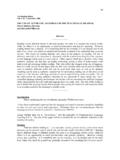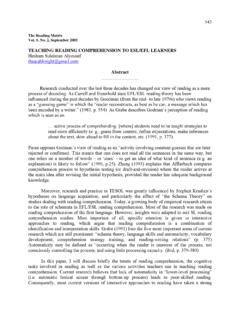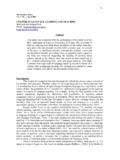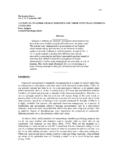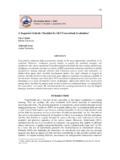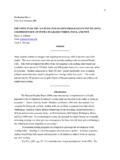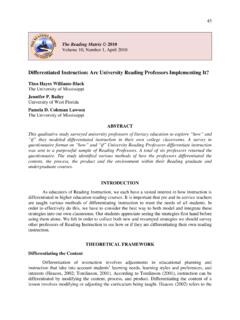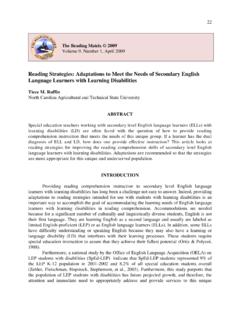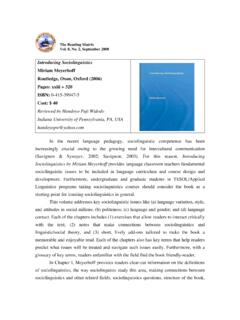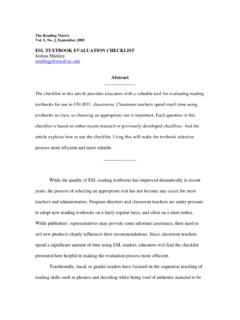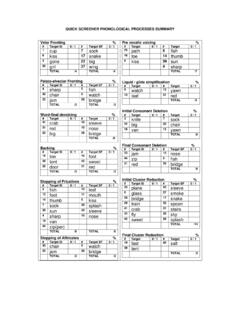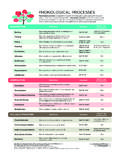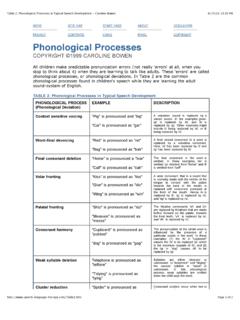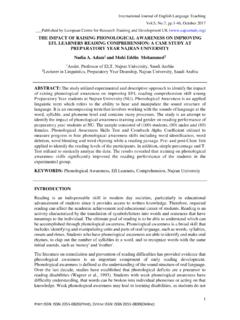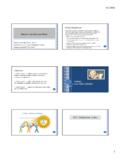Transcription of NATIVE LANGUAGE INFLUENCE ON THE …
1 The Reading Matrix Vol. 1, No. 2, September 2001 NATIVE LANGUAGE INFLUENCE ON THE production OF english SOUNDS BY japanese learners Erdogan Bada Email: Abstract _____ The INFLUENCE of the NATIVE LANGUAGE in learning a foreign LANGUAGE is certainly indispensable. This INFLUENCE can be either positive or negative. In order to observe the circumstances under which this INFLUENCE is positive and/or negative, the following study was conducted in english phonology. The study describes the phonological analysis of japanese speakers learning english as a foreign LANGUAGE .
2 It was carried out at a phonemic level, and reflects learners performance in the target LANGUAGE at a specific stage of interlanguage. A non-comprehensive comparison between the english and the japanese sound systems was made and the so-called problem causing sounds were diagnosed, and were employed in texts and presented to learners for reading. Results obtained from this study suggest that while some sounds were found to pose some difficulty of production , and that the difficulty is attributable to NL, others were produced with much less difficulty due to the already-present NL system of phonology.
3 Other non-interlingual learning strategies were also observed to be employed by the learners in producing english sounds. _____ Introduction Aiming to shed light on english phonemic production of japanese speakers of english , this study draws its theoretical roots from contrastive analysis and the interference theory. Thus, before we proceed with the actual study itself, we would like to provide a concise introduction to these two approaches towards FL learners LANGUAGE output. Throughout the twenty years of its INFLUENCE on the field of applied linguistics, contrastive analysis has proved to be one of the most important studies ever made in describing systems of languages.
4 Two main versions of CA have asserted themselves in the field of foreign- LANGUAGE teaching. The two versions are based on the assumptions of L1 interference1. The strong version (a priori) claims to have the power to predict learners ' errors, while the weak version (ex post facto) diagnoses errors. As L1 interference is central in both versions, the learner's NATIVE LANGUAGE is considered to be an obstacle during the learning process. It is the learner's NATIVE LANGUAGE that impedes or facilitates learning; corresponding points are easy to learn, and thus they offer no problems, while contrasts lead to important problems.
5 Only when linguistic transfer from L1 to L2 is minimized, or eradicated, can learning of a foreign LANGUAGE be possible. Lado (1957) claims that the grammatical structure of the NATIVE LANGUAGE tends to be transferred to the foreign LANGUAGE , and for him here lies the major source of problems in study and acquisition of the foreign LANGUAGE . Those structures that are different will be difficult. ".. in the comparison between the NATIVE and foreign LANGUAGE lies the key to ease or difficulty in foreign LANGUAGE learning.
6 " Fries (1945), who is considered to be one of the most authoritative scholars in contrastive linguistics studies, wrote that the most effective materials are those that are based upon a scientific description of the LANGUAGE to be learned, carefully compared with a parallel description of the NATIVE LANGUAGE of the learner. From what we understand in the above statements, contrastive analysis proponents believe that through description of both systems of the languages (L1 and L2), the areas that might ease learning and/or cause difficulty to the learner would be revealed, and a schedule prepared accordingly would provide the classroom teacher with ready material to make use of in the classroom.
7 Dulay, Burt, and Krashen (1982:97-98), resisting contrastive analysis-based material, present the result of available empirical data that address the CA hypothesis: 1. In neither child nor adult L2 performance do the grammatical errors reflect the learner's L1. 2. L2 learners make many errors of grammar that are comparable in both the L1 and L2 errors that should not be made if "positive transfer" were operating. 3. L2 learners ' judgements of the grammatical correctness of L2 sentences are more related to L2 sentence type than to their own L1 structure.
8 4. Phonological errors exhibit more L1 INFLUENCE than do grammatical errors, although a substantial number of the L2 phonological errors children make are similar to those made by monolingual first LANGUAGE learners , and only a small portion of phonological errors in reading are traceable to the learner's L1. The above results may demonstrate that CA not only falls short in predicting learners ' errors, but also may mislead teachers into adopting material regardless of the learners ' ordering of acquisition of the foreign LANGUAGE .
9 But still, contrastive analysis may have a great deal to contribute, and this contribution is not to be ignored. Sajavaara (1981) states that the principles constituting contrastive analysis have greatly changed, and it is this change that led to criticisms made about contrastive analysis: ".. the theoretical objectives were almost entirely forgotten in the wake of Weinreich's (1953) and Lado's (1957) work," and afterwards, CA tended to concentrate on practical studies of teaching the foreign LANGUAGE , which may later be called "the strong version" of CA, and may be considered as one of the primary causes of "the controversy which ensued in the 1960's.
10 " Although cultural interaction and cultural transfer (other than the psychological INFLUENCE of old habits on L2 : interference) was the other principal objective of CA, its proponents have greatly ignored such, and mainly concentrated on `interference' only. Either with its very limited meaning (as in the transfer of NATIVE - LANGUAGE rules to second LANGUAGE ) or broad meaning (bilateral transfer of cultural, social norms between languages), interference has often been a moot point that closely concerns second- LANGUAGE acquisition.
